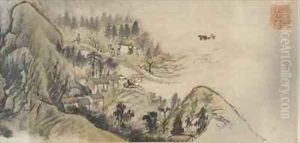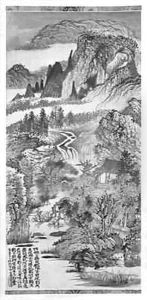Shitao Daoji Paintings
Shitao, also known as Daoji after his monastic name, was a Chinese landscape painter and poet during the early Qing dynasty. His original name was Zhu Ruoji, and he was a member of the Ming royal family. Born in Quanzhou County in Guangxi province, Shitao later became a member of the Buddhist monastic community, which greatly influenced his work and philosophy. He is considered one of the most individualistic and creative painters of the Chinese tradition.
Shitao's life was marked by the dramatic fall of the Ming dynasty. As a child, he escaped the political turmoil that came with the conquest of the Ming by the Manchu-led Qing dynasty. He became a Buddhist monk at the age of 18 and traveled widely throughout China, which exposed him to a variety of landscapes and artistic traditions. His travels and observations profoundly impacted his artistic style, which was both innovative and deeply rooted in the Chinese scholarly tradition.
Known for his remarkable versatility, Shitao worked in all the traditional categories of Chinese painting, including landscapes, human figures, and still lifes. His style is notable for its expressive brushwork and the use of ink play, which were radical departures from the prevailing styles of his time. He is particularly famous for his landscape paintings, which often conveyed a sense of spontaneity and individual expression. Shitao's philosophy of painting, which he outlined in his treatise 'Hua Pu' ('The Painting Manual'), was based on the idea of 'yi hua', or the 'unity of painting', where he emphasized the importance of personal expression and the unity of the universe.
Shitao's work had a lasting impact on the development of Chinese painting, influencing later painters such as the Eight Eccentrics of Yangzhou and other artists who valued individuality and expressive freedom in their work. Despite his royal lineage, Shitao lived a humble life and his paintings were not widely recognized during his lifetime. However, his art and ideas became highly influential in later centuries and he is now considered one of the great masters of Chinese painting.

